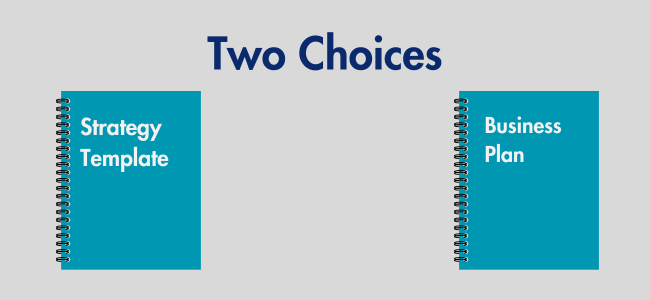

Table of Contents
Solopreneur strategy vs planning confuses many solopreneurs.
In this article, we set the record straight on strategy vs. planning and give you a smarter way to build your strategy and create your business plan.
I’ll share with you the lessons I learned after fourteen-plus years as a solopreneur and how you can use strategy and planning to increase sales and land more clients.
For quick reference, here are the key differences between solopreneur strategy vs planning.
We’ll cover each of these in detail.
| Your Strategy… | Your Plan… |
| Is a set of choices you make to win in your sandbox (market) | Is a set of choices you make on your costs to run your business |
| Shows the assumptions you test with your audience | Shows how you will share your message(s) with your audience |
| Presents your hypothesis for each assumption | Presents how much you will spend to market your product |
| Requires you to collect data to evaluate your assumptions | Requires you to create financial assumptions |
| Changes as you test, keep and revise each assumption | Changes as you make new choices on where to spend money |
Strategy Starts with Your Choices
One of the first rules of strategy to understand when you’re trying to improve your solo business is that you have to make choices.
And it’s likely your choices wont’ be perfect. This is OK.

I know this sounds strange coming from a consultant; yet, the sooner you get comfortable with imperfection, the more progress you’ll make in finding the right strategy for your business.
Your strategy starts with your choices to tackle these questions:
- What is the big problem you can solve for your customers?
- What unique traits will your product have that will solve the big problem?
- Will your customers buy your product if it solves their problem?
As you build your strategy, you’ll need time to test your assumptions and track the outcomes. There is a ton of trial and error. You won’t find the right approach straight out of the gate.
Strategy takes time, and you’ll make plenty of mistakes along the way before you land on the right approach.
Don’t give up. I promise it’s worth it as your strategy gets sharper and you see clients take notice.
Start with your assumptions.
Start with Your Assumptions
Your first assumption is that you’ve found the big problem that your customers want you to solve.

This might include:
- Single dads need an easy way to find a nanny
- Couples want a food delivery program that is low-calorie and vegetarian
- New gardeners need a course on how to grow roses in Alaska
The second assumption is that the product you’re building will solve the problem in a unique way.

This begins your trial-and-error. To make sure you start on the right path, take the pulse of a few people who you think have the challenge you want to fix.
- Reach out to a few of the single dads you know and ask them about how they get leads for a great nanny
- Ask your couple friends and see if any of them use a food delivery program; if they do, ask them what they like and dislike
The key is to gather data so that your product zeroes in on the problem and finds a smart solution.
As you adapt each part of your solution, you’ll have an idea of how it should impact your audience. The outcome that you expect to occur when potential customers test your product is your hypothesis.
Develop your Hypothesis Flow
As you test your assumptions for your new product, you’ll see differences between ‘what you thought people might think’ and ‘what they believe.”

- Perhaps you thought that single dads would want to use an online service to find a nanny when they prefer to get referrals from friends
- Maybe you thought couples would already know how to cook the food once it arrives, when actually they prefer an app that gives a demo on how to prepare the recipe
Each time you receive new customer data, you have to keep or alter a specific assumption. And with each new set of assumptions and changes to your product, your hypothesis will also change.
It’s this process of looking at your assumptions and changing your hypotheses that improves your product.
The feedback you get from potential customers and your test audience is gold. And it’s important that you collect it, store it, and review it in a smart way.
Collect, Store and Review Your Feedback
There are three easy ways to collect, store, and review feedback about your product.

- Surveys
- Social Media
- Video Chats
Surveys
Surveys are powerful since you can ask specific questions, create an automatic process to deliver them, and then easily analyze the results. Two of the more well-known survey services include Survey Monkey and Google Forms. Each one helps you build questions, automate the survey process, and receive feedback.
You might want to offer an incentive for folks who complete your survey so that you get a higher response rate. If you want help on how to build a helpful survey, you can consult Survey Planet. Once you put your survey into action, be sure to store the results and review them.
It’s vital that you advance your assumptions and hypotheses to reflect the survey data you receive.
Social Media
As a solopreneur, social media is an excellent source for feedback on your idea.

Your followers have an interest in your content, and they can be a terrific source of feedback on your new products.
If you use LinkedIn or Instagram ask your followers to comment on the problem you’re solving and your new idea. Do your best to encourage your followers to leave comments and then review them. I also suggest that you reach out to a few followers in your direct messages to see if they’d have a conversation with you about your product.
These chats can reveal important ideas that might take too long to describe in a social media posts. Video chat are a terrific place to start.
Video Chats
Video chats give you the combination of body language and words. Both are helpful when you’re getting feedback.

Ask a few general questions about the problem you’re solving and let the person describe to you their views. While each conversation is unique, I guarantee you’ll hear common themes about the problem you’re trying to fix.
Take notes, review them, and then put the comments into categories. The feedback you gather with surveys, social media and video conversations will reshape your assumptions and hypotheses. You’ll continue to improve your product over time to reflect the continuous feedback you get from current and potential customers.
Once you have a strategy that targets the big problem and a product that fixes it, you can develop your plan.
Create Your Plan
When your strategy is complete, it’s time to create a plan to put your ideas into action.

- A single-page strategy template that shows your assumptions and the outcomes you expect. Show the sandbox where you think you can win and how you expect customers to react to your solutions.
- A business plan that shows your costs, along with other insights such as operations and legal; this document is a bit more robust and includes important items to help you run the business.
I encourage you to write a business plan and explore key areas, such as working with a virtual assistant and a bookkeeper.
For now, let’s focus on your single-page plan and start with the tools you’ll use to share your product with your audience.
Understand Your Costs
You have several choices when it comes to spending money to share your new product with your audience.
The good news is that there are many free options, which I encourage you to test. There are also several good options that may carry a monthly or annual fee.
The benefit of creating your 1-page cost sheet is that you can look at each choice and make smart choices that fit with your budget. Here are a few free solopreneur tools you can explore for marketing your product:
- Beehiiv is a strong platform for building your newsletter
- Convertkit let’s you create landing pages, email sequences, and a newsletter
- Senja lets your customers create testimonials that you can post on your social media accounts, website, and newsletter
Create your Financial Assumptions
When you start your business it helps to put together the basic financials.

You don’t need to build a huge model. Simply show the major, up front expenses, subscriptions and equipment you may want to buy.
You may not have any sales in the first several months, which is fine.
Before you sign up for monthly subscriptions to online services be sure to use all the free services. You may find that you don’t need to purchase any subscriptions for several months since the free options give you plenty of ways to send surveys and market your product.
If you are good with spreadsheets and basic financial concepts than build a budget that shows how much you could spend on items such as a website or freelancer. If you need some help with your budget you can chat with a financial advisor or consider working with a freelancer.
While it’s not mandatory that you have a solopreneur website you may find that people search for your or your product once you start to market it.

Even a simple website makes you and your product look impressive and it’s still one of the first places people go to learn about what you offer. One you have your initial budget take a few months to put your tools into effect.
Remember, strategy takes time and your audience won’t start to buy on day one.
Review Your Finances and Adjust
After the first few months of presenting your product you may decide to spend more money.

You might need to add a few bells and whistles to your product based on the feedback you receive. If you can afford to run additional surveys to new potential customers, than go for it.
If you have the money to buy ads on Facebook or other sites to promote your product than do it. Your goal is to get consistent customers to buy your product and give you feedback. If you find that people aren’t buying your product than it could be your strategy is off the mark.
In this case go back to your strategy and review your assumptions and hypothesis.
Conclusion
When you decide to launch a new product, and you’re comparing your solopreneur strategy vs planning, it’s vital that you create two separate documents:
- A strategy
- A plan
Your strategy is a collection of assumptions you make about the problem you’ll solve and the unique solution you build to solve it. Your plan is either (a) a one page cost summary of the tools you’ll use or (b) a comprehensive business plan. Both a single page plan and a business plan are important. You can start with the one page cost plan and then develop your business plan as you advance.
Remember not to develop a strategic plan. Strategy and planning are two different concepts, and you should explore them in two different documents.
FAQs: Solopreneur Strategy vs Planning
Should you start with your strategy or your 1-page plan?
I suggest you start with your strategy.
Draw a simple flow chart that shows the problem you want to solve, the assumptions you make for your solution, and your customer reaction. Change this along the way as you gather feedback.
Here’s a free strategy template to get you started.
What do solopreneurs struggle with the most?
One of the biggest struggles for solopreneurs is loneliness. There are online gurus who tell you to leave your corporate job and start a business. They’ll tell you it’s the only way to live your life. The truth is that building a business in your home office means you spend many days on your own.
You don’t have the daily company of work friends and the meetings to exchange ideas. You can feel overwhelmed, at times, when you have to solve every problem in your business.
The key is to develop a few outlets to clear your mind and re-build your strength. I try to meet at least once a week, in-person, with other solopreneurs who have the same battles. It’s helpful to exchange ideas and hear of other ups and downs in solopreneur lives. While I encourage you to believe in yourself and start a solo venture, it’s important you know that there are many days when you’ll be on your own.
What happens if no one wants to give you feedback on your idea?
You might have to add an incentive for people to give you the feedback you want. This might include a lead magnet or a tool that they want in exchange for completing your survey. It’s usually more effective to start with your friends who have the problem you’re trying to solve. They might not be as candid with you as strangers, yet they’ll certainly be a great start.
Helpful Resources
Solopreneur Doorway Newsletter
Every Wednesday, solopreneurs around the world read the Solopreneur Doorway newsletter to discover growth ideas in less than 3 minutes. It’s free.
When you’re ready, you can discover your custom, 90-minute strategy session.
We’ll dive into every aspect of your strategy and plan to find what’s missing and fix it.
Until then, keep up the excellent work!
Recent Posts
Choose Your Category
About Erik

Erik Duncan has over 17 years of business and finance experience including investment banking, investment management and starting a successful finance company. He received his MBA in Finance from The Wharton School of Business and his MHA from The University of Iowa.
Your Store Causing You Stress?
A free chat with Erik clears your mind and gives you immediate ideas.
"*" indicates required fields

